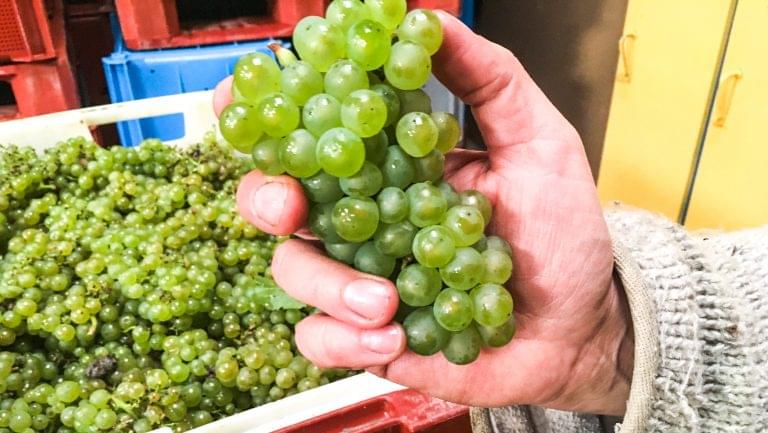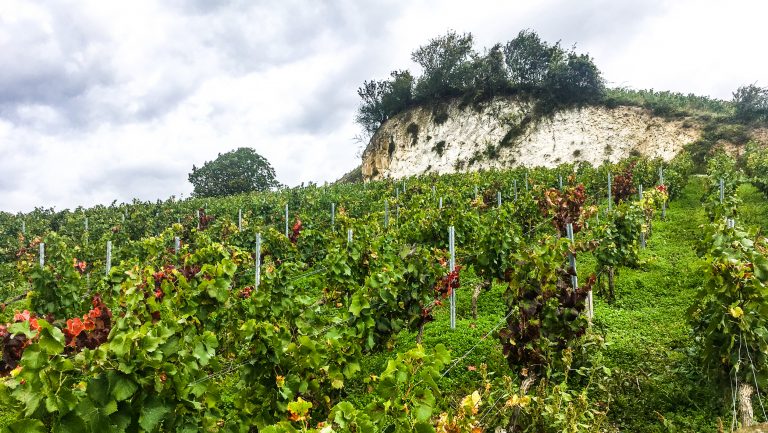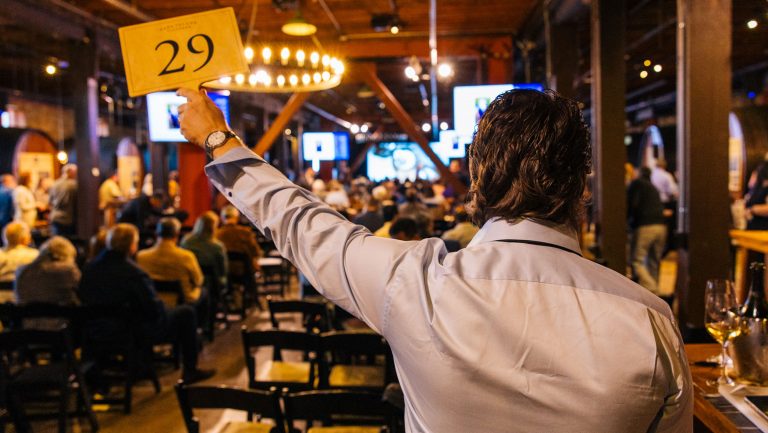Champagne is marginal to the extreme. It is no small miracle that Champagne, at the northerly latitude of 49°N, has become one of the world’s most famous wine regions.
The severe climate and chalky soils are what gives Champagne its racy acidity and age-worthy nobility; however, the fragile growing conditions also mean that producers are often fighting an uphill battle with frost, hail, rain, and poor soils, which can cause rot, mildew, chlorosis, poor ripening, and a plague of pests.
Although it might be a tough terroir to work with, the extra effort certainly pays off for growers and producers alike as Champagne grapes and wines command some of the highest prices globally.

Don’t miss the latest drinks industry news and insights. Sign up for our award-winning newsletters and get insider intel, resources, and trends delivered to your inbox every week.
The high risk and high investment value of the wine also means that Champagne has been one of France’s most steadfast adoptees of the chemical revolution in viticulture.
A Change in Champagne Viticulture
The story of Champagne’s viticulture isn’t necessarily a pretty one: It’s been considered one of France’s least-organic wine regions, with some of the most concentrated use of pesticides nationally; and, up until 20 years ago, growers would often scatter trash in the vineyards to enrich the soil.
Attitudes, however, are changing. In the 1970s the first organic pioneers in Champagne appeared and today the Association des Champagnes Biologiques (ACB) has 63 organically certified producers with a total of 600 hectares—and more in the running for organic conversion. Almost 2 percent of Champagne’s vineyards are today certified organic (compared to just 0.5 percent in 2009, according to the Observatoire Régional de l’Agriculture Biologique en Champagne-Ardenne) and there is a growing number of Demeter-approved biodynamic producers in Champagne. Additionally, there are hundreds more producers who, often controversially, profess to be organic or biodynamic without certification.
Why go organic or biodynamic in such a challenging climate?
For many producers, it’s because they’ve felt that chemical farming wasn’t doing any good for the environment or the wines. Organic viticulture uses no pesticides or synthetic chemicals in the vineyard and relies on compost as a fertilizer. Biodynamic viticulture shares these organic principles but also incorporates concepts outlined by Rudolf Steiner: the use of soil supplements (such as chamomile and quartz); an astronomical calendar for planting and harvesting; and balancing predators and prey to manage pests.
While organic farming is widely accepted, critics still consider biodynamic farming quackery. Biodynamic enthusiasts, on the other hand, contest that their vines are stronger and the wines more flavorful, as convert Franck Pascal explains:
“A sick plant is the result of dysfunctions in the soil and/or [the] plant. I wanted to explore how to make the plants live better and you can’t find this out by spraying chemicals. I began [going] organic, but couldn’t see my soil changing as much as I expected. But when I went biodynamic, the soil changed very fast. It became darker; [it] smells better and is more aerated. The vine grows slower but lighter in color and with stronger branches. The grapes have better aeration, maturity, and taste. [On the palate,] I could feel minerality and tension that give the sensation of balance, elegance, and a long finish.”

Pascal is one of a growing movement of small biodynamic producers in Champagne, which includes such grower-producers as Fleury, Larmandier-Bernier, Leclerc Briant, and David Léclapart. However, this quiet revolution is also happening within larger houses.
The largest proponent of biodynamic viticulture in Champagne is Louis Roederer. Although a sizeable Champagne house, producing 3.5 million bottles per year, Roederer is quite unusual in that 70 percent of its production comes from its own estate fruit, whereas most houses buy in the majority of their fruit. This gives it significant control over its viticulture. When Jean-Baptiste Lecaillon took over as chef de caves in 1999, he began a series of trials into different viticulture methods:
“When I took over, the owner told me I needed to drive Roederer into the 21st century. I believe that winemaking of the 21st century is in the vineyards—before then the winery and vineyard were always a separate concept,” explains Lecaillon. “One of my goals was to have more taste from the vineyard, so we stopped using herbicides to get deeper root systems going further in the bedrock. We were trialing organic versus biodynamic and by 2005 it was obvious that the taste, texture, and depth was increased in biodynamic farming. My only goal was to make delicious wines. They just happened to be biodynamic.”
This year, 83 percent of the vineyards used for Cristal and Roederer’s top cuvées are farmed biodynamically, but the change—especially as an eminent house—hasn’t been easy. “A lot of people criticized us when we stopped using herbicides, and when we went biodynamic people started saying we were crazy. It was very difficult for my team because the industry was laughing at us.”
But no one is laughing now, and several other large houses are reportedly experimenting in organic and biodynamic conversion. Lecaillon is, however, realistic about the limits of biodynamic viticulture in a wine region on the fringe. “Biodynamic works on the top terroir,” he says diplomatically. “Biodynamic is no magic, it can fine-tune and really give an extra dimension to top terroir, but in my experience it just doesn’t work on difficult terroir, because difficult terroir is difficult, and maybe on those terroirs you need chemistry!”
And chemistry certainly remains the order of the day for the majority of Champagne’s 15,800 growers, who don’t want to risk losing their crop or dropping yields by converting. Organic or biodynamic vines can yield 30 percent less than intensively farmed vineyards, which translates into significantly lower earnings, especially if the Champagne house or buyer is skeptical about any benefit found.
“I’m not convinced about the impact on the profile of the wines, and we rely on growers for 75 percent of our grapes, so convincing them all on specific viticultural practices would be difficult,” says Fabrice Rosset, CEO at Champagne Deutz, who admits he has experimented with biodynamic and organic viticulture but prefers the results from conventional—albeit sustainable—farming so far. “It may not be long enough because I understand it takes time to see results in biodynamic practices, but over five years it was not a noticeable difference for us.”
Many Champagne houses share the same sentiment—that there isn’t a significant enough improvement in flavor to be gained by farming organically or biodynamically. It only increases the already high price.
How Alternative Farming Fares in a Tough Vintage
This year, however, many biodynamic producers claim to have seen another difference. The 2017 harvest saw significant crop losses in Champagne to Botrytis (gray rot) as persistent rains set in during August.
While 2017 will go down in history as a challenging year for Champagne in general, the grass is somewhat greener on the biodynamic vineyards, according to Roederer’s Lecaillon: “All of my biodynamic vineyards were much more resistant to Botrytis this year compared to conventional vineyards. The grapes came in with very little Botrytis, but it was a different story for growers using conventional farming.”
While no one escaped the onset of Botrytis this year, organic producers too believe their vineyards were naturally more resistant and balanced. “In 2017, we had exceptionally dry weather from April to the beginning of July,” explains organic producer Pascal Doquet, president of the ACB. “A problem for the conventional chemical growers this year was Botrytis. Without rain in spring, the organic or chemical fertilizers were sleeping on the top of the soils until July, not available to the roots of the vines. So nitrogen was a big problem for vineyards planted without grass, like the many Champagne vineyards that use herbicides. In organic vineyards [which typically have grass planted between rows of vines] we didn’t have a Botrytis problem.”
It is still early to assess the 2017 vintage, and indeed early to assess farming methods’ impacts on overall quality. As Champagne is typically laid down between two and 15 years before release, time will tell how significant the impact of biodynamic and organic farming is on the flavor profile of the wines. But curiosity is undeniably growing in the new generation.
“There is more interest, especially in the younger generation, who often come into contact with biodynamic practices through the Groupe des Jeunes Vignerons de la Champagne,” says Caroline Henry, author of “Terroir Champagne,” a guide to sustainable, organic, and biodynamic cuvées. “Several are experimenting, but very few have converted into certification. This is partly because to be certified, the whole domaine needs to be certified, something which often isn’t so easy to sell to the older generation or the rest of the family. Many domaines have multiple stakeholders, and decisions which impact the yield (hence the income) have to be agreed [to] by all of them. There’s a certain openness which was less obvious ten years ago, but it is still quite marginal.”
Marginal though it may be, going organic or biodynamic in the challenging climate of Champagne has become less taboo. There are also moves in the greater industry to become more eco-friendly and sustainable. Many Champagne growers consider themselves to be practicing lutte raisonnée (translated as a ‘reasoned struggle’), whereby they try to be organic but use synthetic treatments in tough vintages. There are also a range of sustainable viticulture associations in Champagne, and new sustainability certificates like the Viticulture Durable en Champagne introduced by the Comité Champagne in 2014.
The Champagne Conundrum
Compared to other wine regions in France such as Burgundy, the Loire, Alsace, and the Jura, Champagne is still slow on the uptake of biodynamic and organic farming. As well as the challenging climate, this can also be attributed to the very different marketing and business structure of Champagne, as Pascal Doquet explains:
“If you are a grower, in Burgundy or the Jura for example, and you are organic and make good wines, you have access to an international community of connoisseur customers who are searching for new terroirs. You can charge a higher price for your lower yields. It is very different in Champagne, because people only know the name of the great houses, not the villages of Champagne. So, we are like David versus Goliath, without the marketing impact of the great houses.”
Champagne houses sell over three-quarters of the Champagne sold, and the market recognizes and consumes luxury brands, not individual vineyards. There are 300 Champagne houses, and 15,800 Champagne growers spread over 33,800 hectares. This means that inevitably houses must blend grapes from several villages and regions within each vintage, and to make non-vintage Champagne (which is around 95 percent of the production) this is magnified by blending different years. Separating organic and biodynamically farmed grapes is a serpentine task that is unlikely to be achieved until there is a greater market demand.
Where there is an increasing market demand is for vineyard-focused single estate and grower Champagnes. However, the shift towards organic and biodynamic farming Champagne is decidedly gradual. But it is a wine region that moved entirely from flat to fizz: Change in Champagne is possible and can even be miraculous.

Dispatch
Sign up for our award-winning newsletter
Don’t miss the latest drinks industry news and insights—delivered to your inbox every week.
Amanda Barnes is a British wine writer who since 2009 has been based in South America, where she specializes in the wines and regions of Argentina, Chile, Brazil, and Uruguay and writes the South America Wine Guide. Ever footloose, she is currently on a mission to travel Around the World in 80 Harvests.







